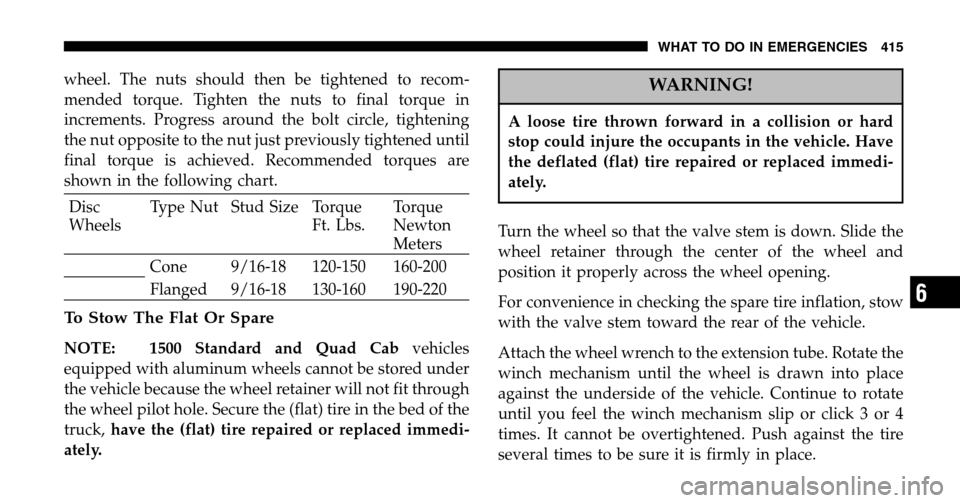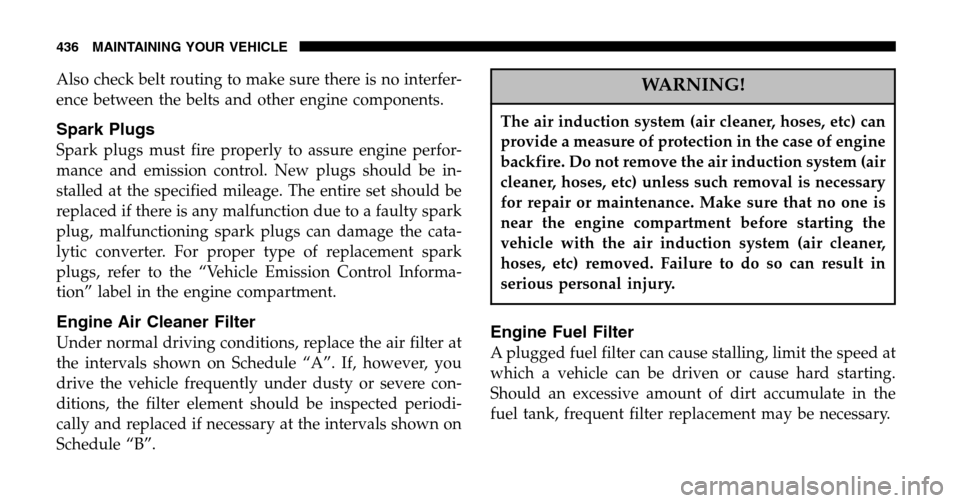Page 370 of 536

TRAILER TOWING
In this section you will find safety tips and information
on limits to the type of towing you can reasonably do
with your vehicle. Before towing a trailer carefully re-
view this information to tow your load as efficiently and
safely as possible.
To maintain warranty coverage, follow the requirements
and recommendations in this manual concerning ve-
hicles used for trailer towing.
Common Towing Definitions
The following trailer towing related definitions will assist
you in understanding the following information:
Gross Vehicle Weight Rating (GVWR)
The GVWR is the total allowable weight of your vehicle.
This includes driver, passengers, cargo and tongue
weight. The total load must be limited so that you do not
exceed the GVWR.
Gross Trailer Weight (GTW)
The gross trailer weight (GTW) is the weight of the trailer
plus the weight of all cargo, consumables and equipment
(permanent or temporary) loaded in or on the trailer in its
� loaded and ready for operation�condition. The recom-
mended way to measure GTW is to put your fully loaded
trailer on a vehicle scale. The entire weight of the trailer
must be supported by the scale.
Gross Combination Weight Rating (GCWR)
The gross combination weight rating (GCWR) is the total
permissible weight of your vehicle and trailer when
weighed in combination. (Note that GCWR ratings in-
clude a 68 kg (150 lbs) allowance for the presence of a
driver).
370 STARTING AND OPERATING
Page 374 of 536
Never exceed the maximum tongue weight stamped on
your bumper or trailer hitch. Consider the following items when computing the
weight on the rear axle of the vehicle:
•The tongue weight of the trailer.
•The weight of any other type of cargo or equipment
put in or on your vehicle.
•The weight of the driver and all passengers.
NOTE: Remember that everything put into or on the
trailer adds to the load on your vehicle. Also, additional
factory-installed options, or dealer-installed options,
must be considered as part of the total load on your
vehicle. Refer to the Tire and Loading Information plac-
ard in the Tire Safety Information Section of this manual.
374 STARTING AND OPERATING
Page 394 of 536

CAUTION!
•Do not use a bumper mounted clamp-on tow bar
on your vehicle. The bumper face bar will be
damaged.
•Do not disconnect the rear driveshaft because
fluid will leak from the transfer case and fluid
loss will damage internal parts.
DRIVING OFF-ROAD
Care should be taken when attempting to climb steep
hills or driving diagonally across a hill or slope. If natural
obstacles force you to travel diagonally up or down a hill,
choose a mild angle and keep as little side tilt as possible.
Keep the vehicle moving and make turns slowly and
cautiously. If you must back down a hill, back straight down using
REVERSE gear. Never back down in NEUTRAL, or
diagonally across the hill.
When driving over sand, mud, and other soft terrain,
shift to low gear and drive steadily. Apply the accelerator
slowly to avoid spinning the wheels.
DO NOT REDUCE the tire pressures for this type of
driving.
NOTE:
After off-road usage, particularly in sand or
mud, inspect the underside of the vehicle for accumu-
lated dirt at the propeller shaft, axles, U-joints, brake
rotors and calipers.
Use a hose to clean off any accumulation of dirt or mud.
Check the exhaust system and all exposed components
for any sign of damage.
394 STARTING AND OPERATING
Page 397 of 536
WHAT TO DO IN EMERGENCIES
CONTENTS
�Hazard Warning Lights ..................398
� Jack Location ..........................399
▫ Removal (2500/3500/Mega Cab) ..........399
▫ Removal
(1500 Standard Cab/Quad Cab Vehicles) .....400
▫ Reinstalling The Scissors-Type Jack And Tools
(1500 Models) ........................401
� Changing A Flat Tire ....................403
▫ Removing The Spare Tire ................404 ▫
Tire Changing Procedure ................405
� Hoisting .............................416
� Jump-Starting .........................416
� Freeing A Stuck Vehicle ..................419
� Emergency Tow Hooks — If Equipped ........420
� Towing A Disabled Vehicle ................420
▫ 4-Wheel- Drive Vehicles .................421
▫ 2–Wheel- Drive Vehicles ................421
6
Page 415 of 536

wheel. The nuts should then be tightened to recom-
mended torque. Tighten the nuts to final torque in
increments. Progress around the bolt circle, tightening
the nut opposite to the nut just previously tightened until
final torque is achieved. Recommended torques are
shown in the following chart.
Disc
Wheels Type Nut Stud Size Torque
Ft. Lbs. Torque
Newton
Meters
Cone 9/16-18 120-150 160-200
Flanged 9/16-18 130-160 190-220
To Stow The Flat Or Spare
NOTE: 1500 Standard and Quad Cab vehicles
equipped with aluminum wheels cannot be stored under
the vehicle because the wheel retainer will not fit through
the wheel pilot hole. Secure the (flat) tire in the bed of the
truck, have the (flat) tire repaired or replaced immedi-
ately.
WARNING!
A loose tire thrown forward in a collision or hard
stop could injure the occupants in the vehicle. Have
the deflated (flat) tire repaired or replaced immedi-
ately.
Turn the wheel so that the valve stem is down. Slide the
wheel retainer through the center of the wheel and
position it properly across the wheel opening.
For convenience in checking the spare tire inflation, stow
with the valve stem toward the rear of the vehicle.
Attach the wheel wrench to the extension tube. Rotate the
winch mechanism until the wheel is drawn into place
against the underside of the vehicle. Continue to rotate
until you feel the winch mechanism slip or click 3 or 4
times. It cannot be overtightened. Push against the tire
several times to be sure it is firmly in place.
WHAT TO DO IN EMERGENCIES 415
6
Page 436 of 536

Also check belt routing to make sure there is no interfer-
ence between the belts and other engine components.
Spark Plugs
Spark plugs must fire properly to assure engine perfor-
mance and emission control. New plugs should be in-
stalled at the specified mileage. The entire set should be
replaced if there is any malfunction due to a faulty spark
plug, malfunctioning spark plugs can damage the cata-
lytic converter. For proper type of replacement spark
plugs, refer to the “Vehicle Emission Control Informa-
tion” label in the engine compartment.
Engine Air Cleaner Filter
Under normal driving conditions, replace the air filter at
the intervals shown on Schedule “A”. If, however, you
drive the vehicle frequently under dusty or severe con-
ditions, the filter element should be inspected periodi-
cally and replaced if necessary at the intervals shown on
Schedule “B”.
WARNING!
The air induction system (air cleaner, hoses, etc) can
provide a measure of protection in the case of engine
backfire. Do not remove the air induction system (air
cleaner, hoses, etc) unless such removal is necessary
for repair or maintenance. Make sure that no one is
near the engine compartment before starting the
vehicle with the air induction system (air cleaner,
hoses, etc) removed. Failure to do so can result in
serious personal injury.
Engine Fuel Filter
A plugged fuel filter can cause stalling, limit the speed at
which a vehicle can be driven or cause hard starting.
Should an excessive amount of dirt accumulate in the
fuel tank, frequent filter replacement may be necessary.
436 MAINTAINING YOUR VEHICLE
Page 518 of 536

Adding Fuel........................... 360
Air Cleaner, Engine
(Engine Air Cleaner Filter) ..............436,459
Air Conditioner Maintenance ............... 440
Air Conditioning Refrigerant .............440,441
Air Conditioning System ................277,440
Air Conditioning System, Zone Control ........ 280
Air Pressure, Tires .................... 344,352
Airbag .......................... 43,50,80,86
Airbag Light ...................... 53,109,220
Airbag On/Off Switch ................... 50,86
Airbag, Side ............................ 89
Alarm (Security Alarm) .................26,222
Alignment and Balance ................... 351
Alterations/Modifications, Vehicle ............. 7
Antenna, Satellite Radio ................... 269
Antifreeze (Engine Coolant) ..............448,483
Anti-Lock Brake System (ABS) .............. 331
Anti-Lock Warning Light ...............224,332 Anti-Theft System
..................... 26,222
Appearance Care ........................ 462
Ashtray ............................... 194
Automatic Transmission Adding Fluid ......................... 455
Fluid and Filter Changes ................. 456
Fluid Level Check ...................... 454
Fluid Type ........................ 456,486
Shift Indicator ........................ 222
Shifting ............................. 299
Special Additives ...................... 456
Axle Fluid .......................... 452,486
Axle Lubrication (Axle Fluid) ............... 452
Ball Joints ............................. 441
Battery ............................... 439
Emergency Starting ..................... 416
Saving Feature (Protection) ............... 163
Bearings .............................. 457
518 INDEX